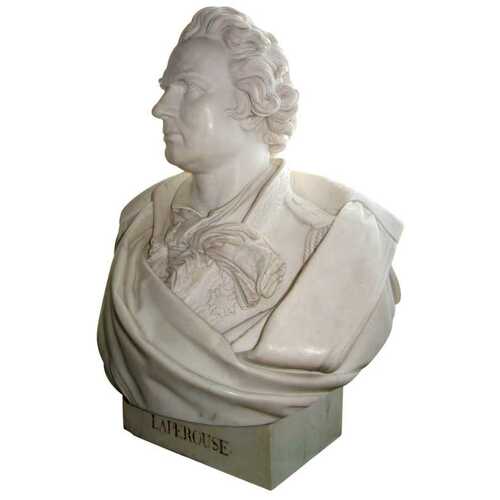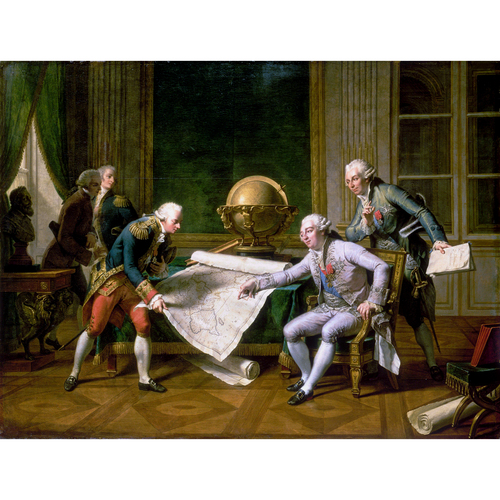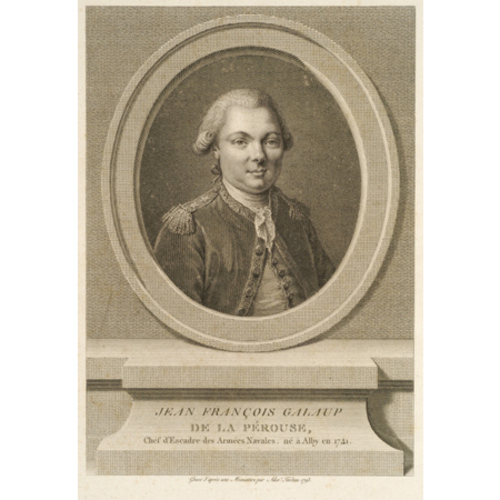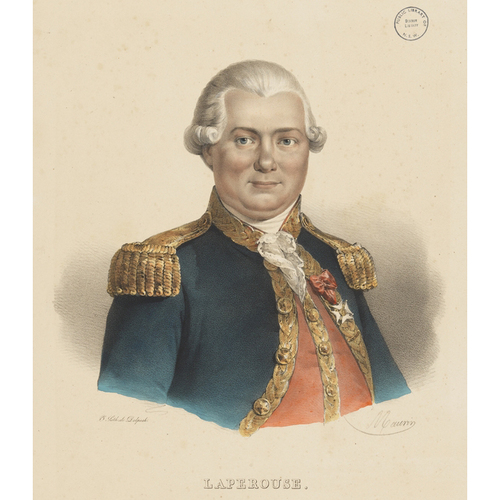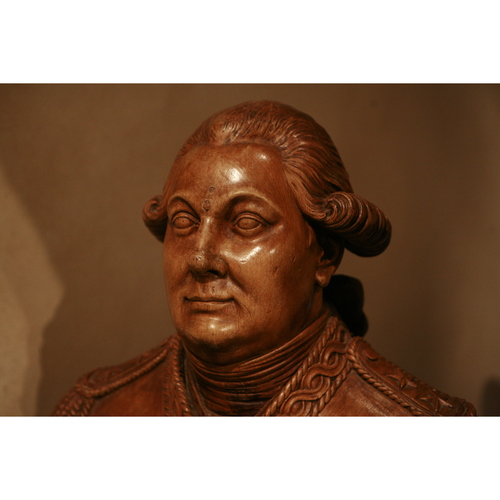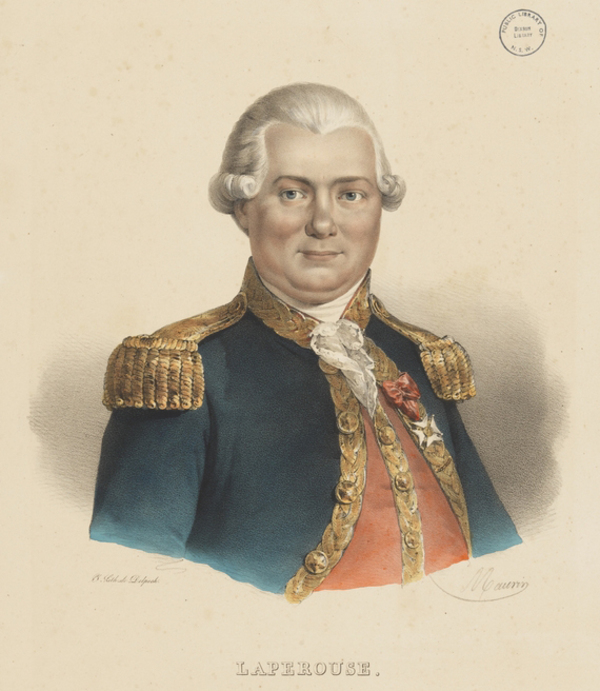
Source: Courtesy of Wikimedia Commons
GALAUP, JEAN-FRANÇOIS DE, Comte de LAPÉROUSE, naval officer; b. 23 Aug. 1741 in the parish of Saint-Julien in Albi, France, son of Victor-Joseph de Galaup and Marguerite de Rességuier; m. 18 June 1783 Louise-Éléonore Broudou in Paris; they had no children; d. in June 1788, at Vanikoro, Santa Cruz Islands.
Jean-François de Galaup joined the navy as a midshipman at Brest on 19 Dec. 1756, and the following March sailed with the Célèbre in the squadron under Comte Dubois de La Motte [Cahideuc*] being sent to relieve Louisbourg, Île Royale (Cape Breton Island). He returned to Brest on 12 Nov. 1757, escaping the terrible epidemic that ravaged both the ships and the town. On 22 Feb. 1758 he joined the frigate Zéphyr in the squadron sent to Louisbourg under Comte Du Chaffault de Besné. On 15 August he was posted to the Cerf, and the following 16 May to the Formidable, a ship of the line in the squadron that the Comte de Conflans was with difficulty fitting out at Brest to protect a prospective landing in England. On 20 November, at the entrance to the Baie de Quiberon, this fleet of 21 ships encountered 23 vessels commanded by Edward Hawke. The Formidable, which was in the rear squadron, had to bear the brunt of the attack and put up admirable resistance. Twice wounded, Lapérouse was taken prisoner but was almost immediately exchanged.
In May 1762 Lapérouse sailed on the Robuste, in the division under Charles-Henri-Louis d’Arsac de Ternay which set out to destroy the British fisheries in Newfoundland. Lapérouse was promoted sub-lieutenant on 1 Oct. 1764, and from 1765 to 1769 he was assigned duties relating to coastal transport in France. In 1771 he saw active service at Saint-Domingue (Hispaniola) aboard the frigate Belle-Poule. Early the following year he left for Île de France (Mauritius) with his patron Arsac de Ternay, who had just been named its commandant general. He left there in April 1773 for a long expedition in the Indian Ocean. Back at Île de France in March 1774, he returned to France in May 1777. On 4 April 1777 he had been promoted lieutenant-commander, and the following month was made a knight of the order of Saint-Louis.
In 1779 Lapérouse received command of the Amazone which, as part of La Motte-Picquet’s division, left on 1 May for the West Indies, escorting a convoy bound for Martinique. Joining the fleet under Vice-Admiral the Comte d’Estaing, Lapérouse took part in the capture of Grenada and in the battle against John Byron’s squadron on 4, 5, and 6 July. Then, on board the Amazone, he was put on the lookout outside Charleston, South Carolina.
On 4 April 1780 Lapérouse was promoted captain, and the following 18 December received command of the frigate Astrée. By this time an expedition had been planned against the British establishments in Hudson Bay, but various difficulties forced a postponement. On 21 July 1781, while patrolling in the waters off Cape Breton Island with the Astrée and the Hermione, Lapérouse fought a brilliant battle with a British convoy and captured two ships. Then he escorted a convoy bound for the West Indies (December 1781) and took part in an attack on Saint Christopher (February 1782) and in battles off the Îles des Saintes against the squadron under Admiral George Brydges Rodney (9 and 12 April 1782). The French fleet was defeated but Lapérouse managed to reach Cap-Français (Cap-Haïtien, Haiti) without mishap. There on 14 May he took command of the ship of the line Sceptre, and on 31 May he set sail for Hudson Bay with the frigates Astrée and Engageante. He took with him 250 soldiers, 40 gunners, four artillery pieces, and two mortars. Despite extreme difficulty in navigating he arrived in Hudson Strait in mid-July, and on 8 August was in sight of the entrance to the Churchill River (Man.). The next day he landed his troops and called upon Chief Factor Samuel Hearne to surrender; Hearne immediately complied. Fort Prince of Wales was partially destroyed, and the stocks of supplies and furs were taken. On 24 August Lapérouse successfully attacked York Factory (Man.). Hard pressed by bad weather, he left immediately, having faithfully carried out his mission without losing a single man; at the same time he had treated his prisoners with the greatest kindness. This campaign earned him a pension of 800 livres.
After peace returned, Lapérouse was chosen by the king because of his extensive experience and his humanity to take charge of an expedition to the Pacific, where numerous regions, including the west coast of North America, were still unexplored. In July 1785, shortly before his departure, Lapérouse was promoted brigadier of the naval forces, and during his voyage was to receive a commission as rear-admiral.
The Astrolabe and the Boussole, the two frigates in the expedition that had been organized with the help of the Académie des Sciences, left Brest on 1 Aug. 1785, easily rounded Cape Horn, and arrived in Concepción Bay (Chile) on 23 Feb. 1786. On 9 April Lapérouse called at Easter Island, and in May at the Sandwich Islands (Hawaii), where he discovered Maui Island, missed by James Cook. On 23 June the frigates came in sight of Mount St Elias (on the Alaska-Canada border). Lapérouse then sailed down the west coast of America, undertaking many hydrographic surveys. On 14 September he reached Monterey (Calif.), where Esteban José Martínez came to his aid to pilot the two frigates into port. Crossing the Pacific from east to west, he went into Macao, China, on 3 Jan. 1787, and entered Manila Bay on 26 February before heading north. The first European navigator to sail into the waters between China and Japan, Lapérouse found the strait between Yezo (Hokkaido, Japan) and Sakhalin (U.S.S.R.) which bears his name, before putting into Avacha (Tar’ya) Bay on the coast of Kamchatka Peninsula (U.S.S.R.) on 7 September. The interpreter Jean-Baptiste-Barthélemy de Lesseps went ashore to return to France via Siberia, taking with him the reports and maps prepared by his chief.
Lapérouse then sailed in the direction of the central Pacific and cast anchor on 9 December at Maouna (Tutuila, Samoa). He continued towards the Friendly Islands (Tonga) and on 26 Jan. 1788 reached Botany Bay in Australia. He left about 15 March, sailing to the north-east. Caught up in a cyclone, his two frigates were wrecked in the vicinity of the Santa Cruz Islands in mid-June 1788. Lapérouse’s disappearance remained a mystery until Peter Dillon, in 1826, and Jules-Sébastien-César Dumont d’Urville, in 1828, discovered the wreck of the Astrolabe. Finally, Reece Discombe identified the remains of the Boussole in 1964.
Lapérouse is representative of the most accomplished of the 18th-century sailors. An excellent navigator, a brilliant combatant, a humane leader with a mind open to all the sciences of his time, he was always able to combine to advantage prudence and audacity, experience and theory. As resourceful as he was indefatigable, as amiable as he was firm, he had a talent for making everyone like him.
AN, Marine, B4, 125, 138, 142, 145–47, 150, 163–68, 183–85, 191–95, 206, 266, 318–20; C1, 173, p.1439; 179, p.211; 180, p.299; 182, p.454v; 184, p.704; C7, 165 (dossier Lapérouse). H. H. Bancroft [and H. L. Oak], History of the northwest coast (2v., San Francisco, 1884). Georges Bordonove, Grands mystères et drames de la mer (Paris, 1975). M.[-R.] de Brossard, Lapérouse, des combats à la découverte (Paris, 1978); Rendez-vous avec Lapérouse à Vanikoro (Paris, 1964). John Dunmore, French explorers in the Pacific (2v., Oxford, 1965–1969), I. Paul Fleuriot de Langle, La tragique expédition de Lapérouse et Langle (Paris, 1954). Édouard Goepp et Henri de Mannoury d’Ectot, Les marins (2v., Paris, 1877). Lacour-Gayet, La marine militaire sous Louis XV; La marine militaire sous Louis XVI. O.[-J.] Troude, Batailles navales de la France (4v., Paris, 1867–68), I, II.
Cite This Article
Étienne Taillemite, “GALAUP, JEAN-FRANÇOIS DE, Comte de LAPÉROUSE,” in Dictionary of Canadian Biography, vol. 4, University of Toronto/Université Laval, 2003–, accessed December 22, 2025, https://www.biographi.ca/en/bio/galaup_jean_francois_de_4E.html.
The citation above shows the format for footnotes and endnotes according to the Chicago manual of style (16th edition). Information to be used in other citation formats:
| Permalink: | https://www.biographi.ca/en/bio/galaup_jean_francois_de_4E.html |
| Author of Article: | Étienne Taillemite |
| Title of Article: | GALAUP, JEAN-FRANÇOIS DE, Comte de LAPÉROUSE |
| Publication Name: | Dictionary of Canadian Biography, vol. 4 |
| Publisher: | University of Toronto/Université Laval |
| Year of publication: | 1979 |
| Year of revision: | 1979 |
| Access Date: | December 22, 2025 |


